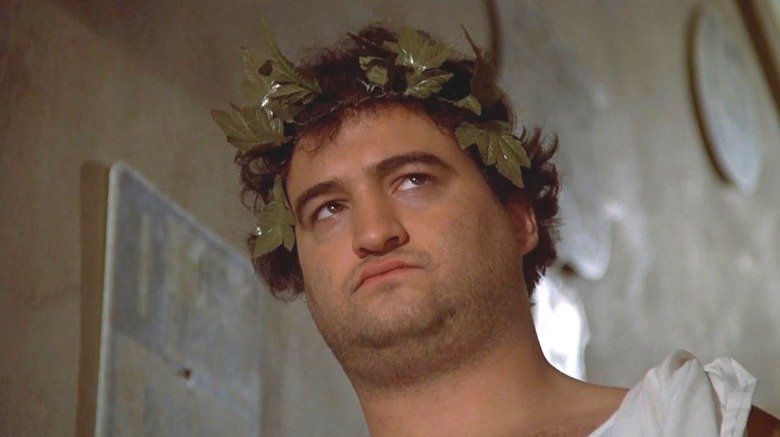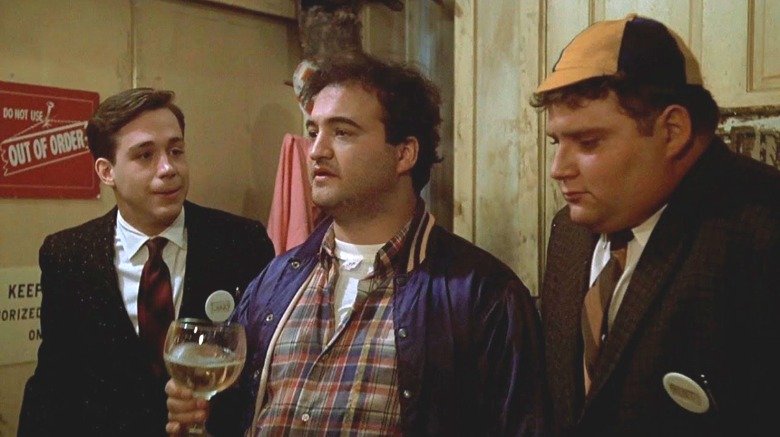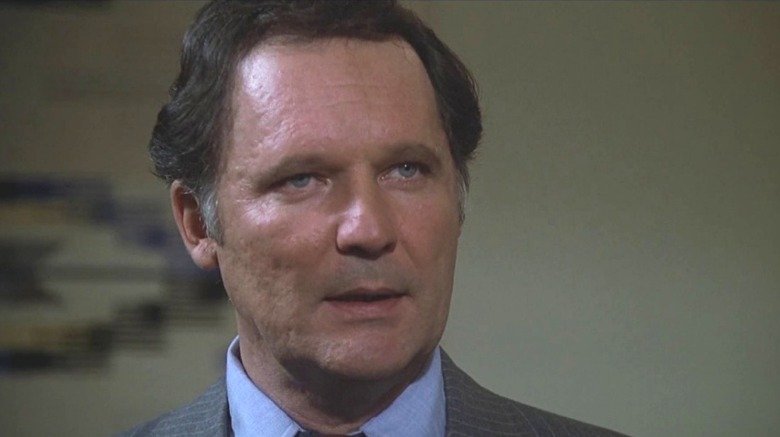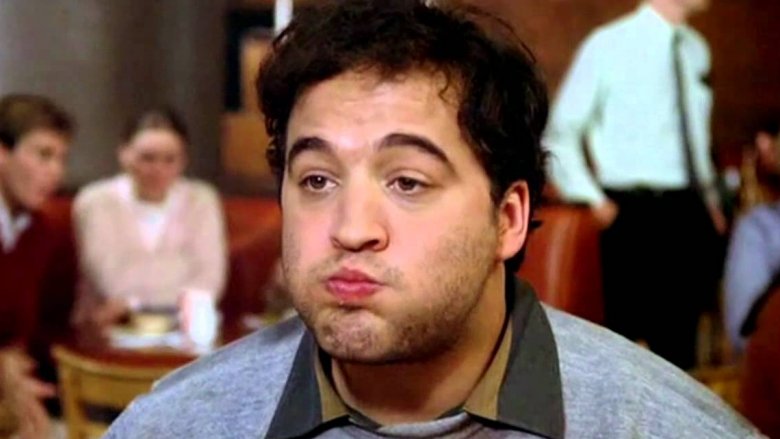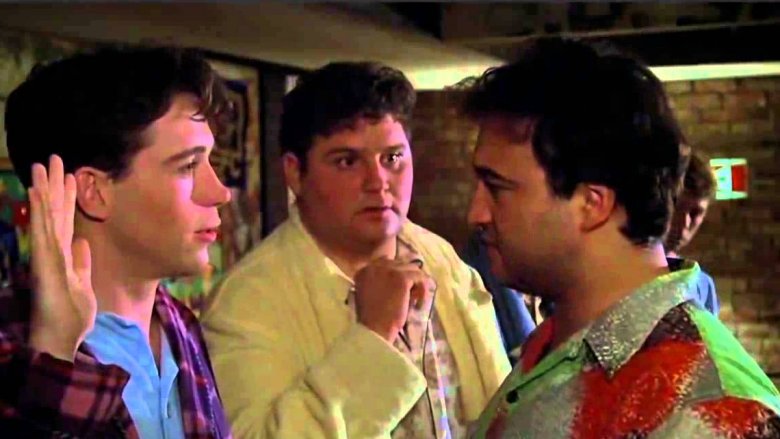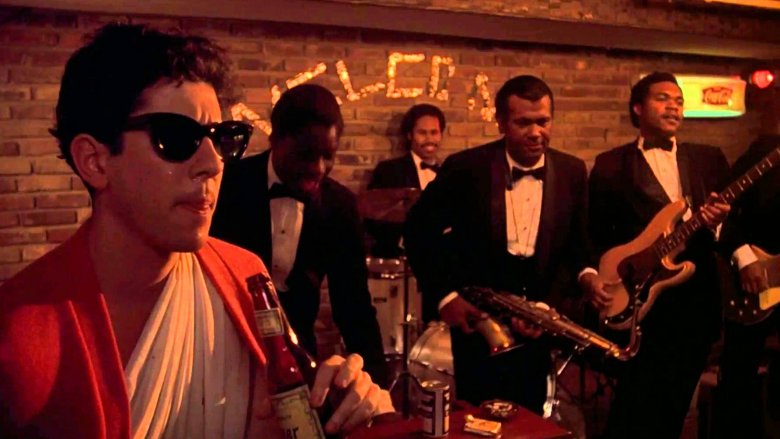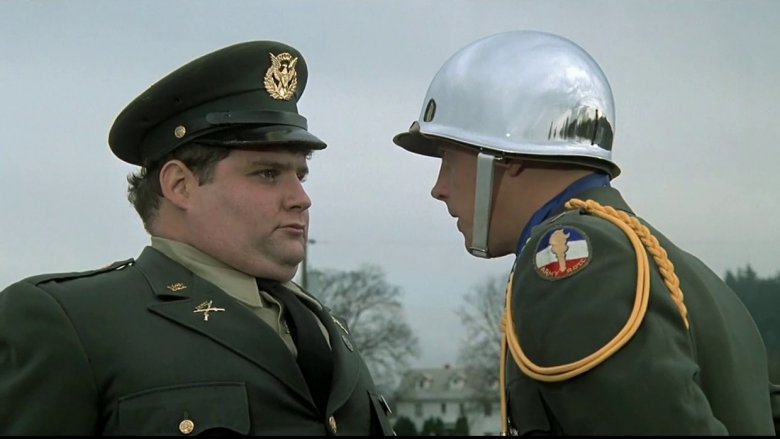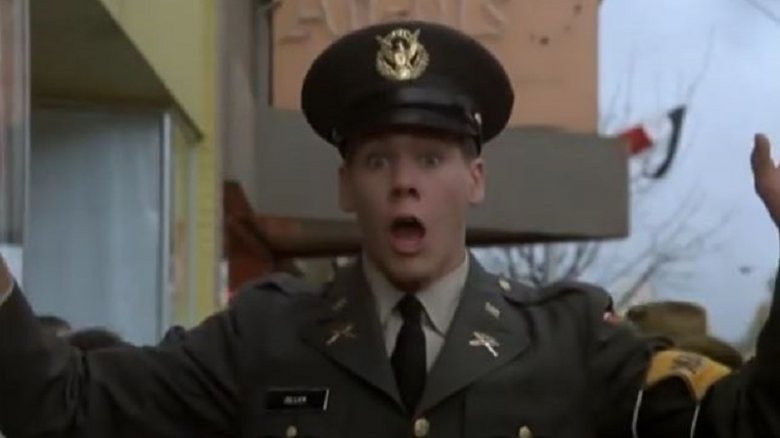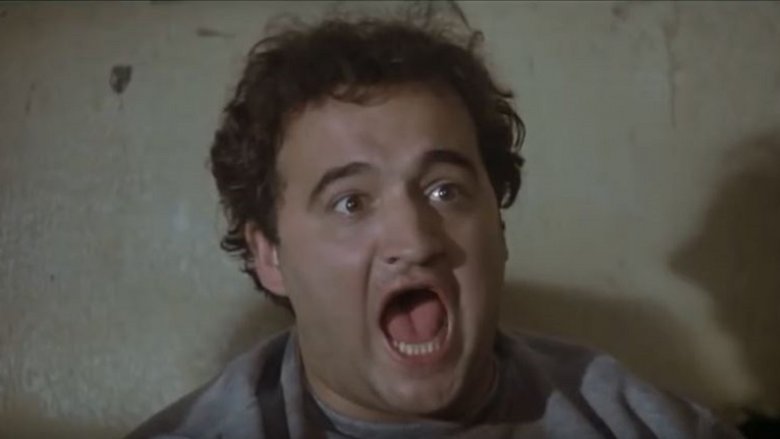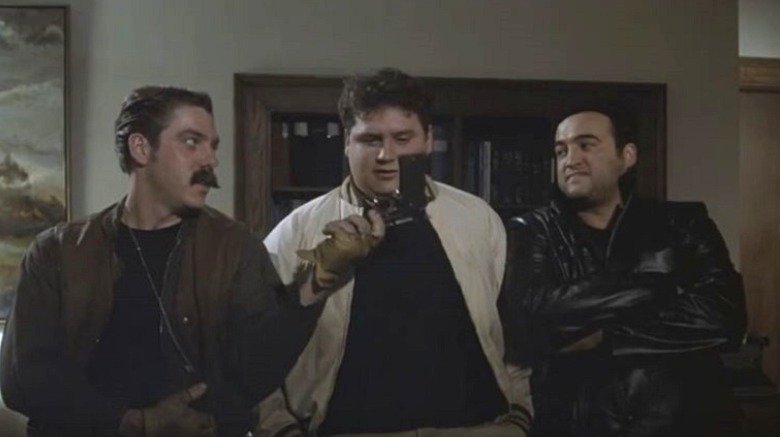The Untold Truth Of Animal House
If you ever went to college — heck, probably even if you didn't — there's a very good chance you spent at least part of your life trying desperately to relive scenes from Animal House. The 1978 frat comedy popularized toga parties, canteen food fights, and the classic college prank of putting a dead horse in the Dean's office. Heck, it even inspired one of the single greatest lines in Futurama, when Mars University's Dean Vernon puts Bender and his Robot House buddies on "dodecatuple secret probation." Oh, and it spent, like, decades as the top-grossing comedy of all time, but you don't wanna hear about stuffy Omega house crud like that. TOGA! TOGA!
Yet as much as Animal House remains a fixture on campuses four decades after its release, the story behind the movie that launched John Belushi's all-too brief career remains strangely unknown. Sure, every film junkie can tell you that Universal thought it would tank on release, or that Dan Aykroyd was originally meant to co-star as deranged biker D-Day, but the twisted, bizarre hijinks that went on behind the scenes? They've somehow escaped pop culture's spotlight glare. Which is a pity, because the stuff that went on when the cameras stopped rolling would've made Bluto Blutarsky run for cover.
Animal House started life as a Charles Manson high school flick
In some parallel universe right now, you're reading an article about the trashiest exploitation flicks and thinking "Wow, this listicle sure is great even by the phenomenal standards Grunge has set itself, also what's this film called Laser Orgy Girls?" That, alt-universe you with excellent taste in reading material, is what Animal House was originally going to be: a Charles Manson-inspired high school flick about a teenage serial killer meeting aliens in the desert. No, you're not the only one wondering how a sex-and-death teen movie wound up becoming a gross-out college comedy.
Bizarre as it was, L.O.G. didn't come outta nowhere. Animal House's producer was Ivan Reitman, someone you probably know as the director of Ghostbusters, but who was once famous as a horror producer. As Stumped Magazine explains, Reitman was coming to the film fresh off two gory David Cronenberg pictures, Shivers (aka They Came from Within) and Rabid. A film about young Charles Manson was right in his ballpark.
Thankfully for everyone but fans of glorious trash, Animal House was already under the creative control of National Lampoon Magazine's Matty Simmons, who wanted to get his brand into showbiz. He vetoed the entire concept and sent writers Doug Kenney and Harold Ramis back to the drawing board. They switched the setting to college and brought National Lampoon writer Chris Miller aboard. Just like that, Charles Manson was out, and fraternity hijinks were in.
The director of Animal House had to trick Chevy Chase into quitting
At the end of the '70s, no show was bigger among baby boomers than Saturday Night Live. The writers of Animal House were keen to tap into this, as their original cast list shows: John Belushi as Bluto, Dan Aykroyd as D-Day, Bill Murray as Boon, and Chevy Chase as Otter. Yep, Animal House was basically gonna be SNL Gatecrashes National Lampoon, and director John Landis couldn't think of anything worse.
Landis joined the crew late, after five directors turned the gig down, and casting choices were pretty ossified. One of the first things he did was shake things up by telling the studio he didn't want to make an SNL movie. Universal was cool with ditching Aykroyd and Murray (who were busy anyway) but wanted to keep rising star Chevy Chase. So Landis had to trick Chase into ditching the movie himself.
In an interview with Page Six, Otter actor Tim Matheson recalled how Landis invited Chase to lunch and deliberately said all the wrong things. Knowing Chase liked to be center of attention, he emphasized how much fun acting in Animal House would be because it was an ensemble piece. Landis contrasted this with how dull acting in Chase's other option, Foul Play, would be because it would just be Chase and Goldie Hawn. Chase left that lunch thinking Animal House was a waste of time. Landis got to cast Matheson as Otter, and Chase got to be leading man in his forgettable thriller.
The Animal House cast bonded by going to real frat parties
With its small budget, Animal House couldn't exactly have a custom set built, so the producers had to ask to film on real college campuses. After getting laughed out of a bazillion meetings, they finally asked the dean of students at the University of Oregon. He was still kicking himself for turning down The Graduate years before and said "yes" without even reading the script. Location locked, Landis sent his Delta frat actors in ahead of schedule to bond. It worked, but definitely not in the way he imagined.
Peter Riegert (Boon), Tim Matheson (Otter), Bruce McGill (D-Day), James Widdoes (Hoover), and Karen Allen (Katy) decided to check out a real frat party. As the Animal House cast later told the New York Times, the actual frat brothers really didn't like these Hollywood types crashing their party. The moment Riegert knocked a cup of beer over, it was open season. Matheson recalled that the football team chased them down and went Apollo Creed on their collective backsides. The result was a cast sporting black eyes, bruises, and missing several teeth.
In the end, assistant director Cliff Coleman saved the day. A veteran of Sam Peckinpah's demented movie shoots, Coleman covered up the fight from John Landis and ensured all the actors got patched up before shooting started (via Stumped Magazine). As for the Animal House cast themselves, they'd later say that brawl was key to getting them to gel so well on screen.
The main writer of Animal House was a tortured, tragic genius
When National Lampoon head Matty Simmons decided to make Animal House, it wasn't just for publicity. It was at least partly to make sure one man stayed on the magazine's writing staff. Meet Doug Kenney, the man behind both Animal House and Caddyshack. In 1978, he was National Lampoon's main writer, and the person basically holding the magazine together. Terrified his star was about to jump ship, Simmons dreamed up the movie project to keep Kenney aboard (via Stumped Magazine). It was the right call. Kenney was a real-life tortured genius.
The Daily Beast has the details. A child prodigy, Kenney was able to pick any random book off a shelf, read a passage aloud, then continue reading in the style of the book, making up a convincing plot as he went along. He basically invented the style of humor National Lampoon became famous for, which is the style of humor that dominated the U.S. box office for decades. He could put on and take off personalities like most people do clothes. And he took this crazy, intense brain and used it to create comedies about sex and drugs and poop.
At least, he did for a while. In 1980, only two years after Animal House made him a hot property, Kenney fell to his death from a cliffside coastal path in California. Although his death was ruled accidental, his friends thought otherwise. "Doug probably fell while he was looking for a place to jump," Harold Ramis said.
Richard Pryor probably saved Animal House
Animal House ain't a PC film. There are scenes in it that absolutely would not make the cut today, like the sequence where the underage Clorette passes out at a party and Pinto totally considers molesting her. But there was one scene studio bosses were scared about even in the politically incorrect world of 1978. The scene where the Deltas go to a roadhouse bar and panic when some black guys join their table had Universal anticipating literal riots in theaters. It might have made sense for the pre-civil rights era of the characters, but not for a studio looking to avoid a PR disaster.
Universal head Ned Tanen, already not all that hot on the gross-out comedy he'd somehow gotten stuck with, was adamant the scene be cut. Stumped Magazine claims he was predicting African-American audiences tearing up their seats. So the producers fought back the only way they knew how. They screened the film for Richard Pryor, then the biggest African-American comedian in Hollywood. Pryor's reaction would save the scene, and, arguably, the integrity of the film itself.
According to an interview with John Landis in the New York Times, a note soon landed on Tanen's desk, marked "From the desk of Richard Pryor." Landis claims it simply read, "Ned, Animal House is (expletive) funny, and white people are crazy." That was all it took. With the blessing of the pope of anti-PC comedy, the roadhouse scene made the final cut.
Stephen Furst only got cast in Animal House because of pizza
Here's a weird thought: had National Lampoon's Matty Simmons not had a craving for a double pepperoni pizza at one specific moment in the late 1970s, Stephen Furst would have never been cast as the hapless Delta Flounder. At the time Animal House was going into production, Furst was an absolute nobody, the kind of actor who isn't so much "resting" as "hopelessly waiting for a big break that clearly isn't gonna happen." Other cast members were unknowns. Furst was an LA pizza delivery boy, a job that's probably even less glamorous than it sounds.
Furst's line of work did mean he often got to meet directors, producers, and casting directors face to face. Sure, only to hand over a pizza and accept a lousy tip, but that's still something. And Furst didn't let his opportunity go to waste. Every time he had to deliver a pizza to someone who might be someone, he stuck his headshot and resume inside the box (via Miami Herald).
As strategies go, it's up there with the pot-smoking high school guitarist whose entire career plan is to upload one video of himself strumming along to Smoke on the Water and wait for his first million subscribers to come rolling in. Yet Furst's gamble worked. One day he was delivering pizza to Matty Simmons, next he was heading up to Oregon to play Flounder in Animal House, the biggest comedy of the decade. Never underestimate the power of Italian fast food.
No one realized Kevin Bacon was even in Animal House
Every young actor dreams of landing a part in a movie as big as Animal House. In 1978, that's exactly what happened to teenage Kevin Bacon. When John Landis came onboard he decided he wanted to fill the movie with unknowns, and Bacon was exactly unknown enough to play smarmy Omega pledge Chip Diller. At the time, the future Footloose star was waiting tables. According to the Miami Herald, he was so clueless about the world of Hollywood that, upon learning that he was being paid scale (i.e., minimum rate) he asked if that was something to do with his weight.
Anyway, Bacon went and did the shoot and went back to waiting tables. A few months later, Animal House came out and suddenly his face was playing on nearly every theater screen in America. At that precise moment, Bacon probably thought he'd just had his big break. He was wrong. In an interview with EW, Bacon later said people at the time wouldn't even believe he was in the movie.
As Bacon put it: "You always fantasize about things like that having a huge impact. But I just went back to the bar where I worked." Look at his filmography and it's clear he's not being modest. After Animal House he had to wait two years for another named part — and that was a swiftly killed character in Friday the 13th. It wasn't until 1982's Diner that his career finally took off.
The real Delta House was a thousand times worse than Animal House
The script for Animal House came from a happy meeting of three great comedic minds: tortured genius Doug Kenney, future Groundhog Day director Harold Ramis, and Chris Miller. A National Lampoon writer, Miller was best known for his short stories depicting the perverse Delta fraternity of Dartmouth University. It was these tales that Animal House's own Delta House was based on. But while Miller certainly was a great comic writer, he wasn't exactly a super-inventive type. The Delta House in his stories was his own, real-life fraternity, Alpha Delta Phi. And their behavior was a thousand times worse than anything in the movie.
One of the big jobs writing the script was deciding what antics from Miller's past a mainstream movie could get away with, and what was beyond the pale even for a movie where a horse dies for a prank. At various points, Miller suggested real-life inspired scenes involving public self-pleasuring, weiner-measuring contests, rituals involving more vomiting than The Exorcist, and a young man using a frozen hot dog in a way the hot dog never signed up for.
Although the general anarchic, gross-out tone remained, much of the awfulness was cut out by director John Landis, who claimed the Deltas were too disgusting to root for. He was probably onto something. It's hard to imagine Bluto appearing so lovable if audiences had to watch him, as Miller wanted, putting out seven fires purely by barfing on them.
The proposed Animal House sequels were borderline insane
Almost uniquely for a movie that raked in many millions of dollars, Animal House never got a sequel. Hollywood recognized that it was too unique, too artistically perfect to spoil it with — Ha! Kidding. Barely were the first reviews in than studio executives were banging on the writers' doors, their eyes replaced with gigantic dollar signs. The reason Animal House stands alone is really because all the proposed sequels were way too crazy to ever make.
At one end of the scale, this involved rebooting Animal House with a female cast. Given that the last female-oriented project the all-male writing, producing, and directing team had worked on was called Laser Orgy Girls, this could have gone very poorly. Still, at least it made conceptual sense. At the other end of the scale, you have the proposed script that transplanted D-Day's character into Central America and had him lead a Sandinista-style revolution (via Miami Herald). Yep, the plan was once to follow up Animal House with Drunk Rambo Goes to Nicaragua.
Despite these hiccups, the writers finally managed to settle on a workable idea. They would reunite the cast in 1967 San Francisco during the Summer of Love and have them wreak havoc. Unfortunately, writer Doug Kenney went to the great frat party in the sky in late 1980, and John Belushi followed him about a year and a half later. Plans for a sequel were axed.
Animal House inspired a truly terrible TV spinoff
M*A*S*H is one of the most successful spinoffs ever. A 1972 sitcom based on the movie, it pulled in so many viewers that its single-episode record wasn't broken until Super Bowl XLIV in 2010 (via The Guardian). Thanks to numbers like that, TV execs spent the '70s and '80s trying to make spinoffs of every successful comedy film (see the dreadful Ferris Bueller's Day Off sitcom), and Animal House was no exception. Not that 1979's Delta House was the next M*A*S*H. In fact, it wasn't even the next Joey.
This is kinda surprising given the talent involved. As movie blog The Dissolve explains, Ivan Reitman came back to produce, John Hughes took over scripting duties, and D-Day, Flounder, Hoover, and Dean Wormer all returned to reprise their roles. Somehow all that talent managed to produce a show of literally zero artistic value.
The trouble was, network TV in 1979 was a squeaky clean wasteland devoid of all the naughtiness in Animal House. In other words, it was in the hands of real-life Dean Wormers, and you better believe they were gonna stick any producers that challenged them on double secret probation. Sadly, Delta House the TV show was way less rebellious than actual Delta House, and they meekly complied with ABC's requirements (via Rolling Stone). The result was an Animal House without anything even vaguely animalistic about it. And who the heck would want to watch a show just called House?
